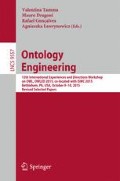Abstract
With the growing interest in using ontologies in semantically-enabled applications, the interest in enhancing the quality of such ontologies has grown as well. Standard reasoning services focus on certain obvious dimensions of quality, e.g., to detect inconsistencies and incoherence. In addition, bespoke tools have been presented to address the completeness dimension of quality, e.g., missing entailments. These tools are usually focused on very restricted subsets of all the possible missing entailments, i.e., only atomic subsumptions. We present a new protocol to detect both existing invalid entailments and missing valid entailments. We also present a case study to evaluate the usefulness of the presented protocol for ontology validation purposes.
Access this chapter
Tax calculation will be finalised at checkout
Purchases are for personal use only
Notes
- 1.
In MCQ terminology, a correct answer is referred to as a key and a wrong answer is referred to as a distractor.
- 2.
In a multiple-response question, more than one answer can be correct.
References
Alsubait, T., Parsia, B., Sattler, U.: Generating multiple choice questions from ontologies: How Far Can We Go? In: Lambrix, P., Hyvönen, E., Blomqvist, E., Presutti, V., Qi, G., Sattler, U., Ding, Y., Ghidini, C. (eds.) EKWA 2014 Satellite Events. LNCS, vol. 8982, pp. 66–79. Springer, Heidelberg (2015)
Alsubait, T., Parsia, B., Sattler, U.: Generating multiple choice questions from ontologies: Lessons learnt. In: The 11th OWL: Experiences and Directions Workshop (OWLED 2014) (2014)
Alsubait, T., Parsia, B., Sattler, U.: Measuring similarity in ontologies: a new family of measures. In: Janowicz, K., Schlobach, S., Lambrix, P., Hyvönen, E. (eds.) EKAW 2014. LNCS, vol. 8876, pp. 13–25. Springer, Heidelberg (2014)
Alsubait, T., Parsia, B., Sattler, U.: Measuring similarity in ontologies: How bad is a cheap measure? In: 27th International Workshop on Description Logics (DL-2014) (2014)
Baader, F., Ganter, B., Sertkaya, B., Sattler, U.: Completing description logic knowledge bases using formal concept analysis. In: Proceedings of IJCAI 2007 (2007)
Bertolino, A., DeAngelis, G., DiSandro, A., Sabetta, A.: Is my model right? let me ask the expert. J. Syst. Softw. 84(7), 1089–1099 (2011)
Dragisic, Z., Lambrix, P., Wei-Kleiner, F.: Completing the is-a structure of biomedical ontologies. In: Galhardas, H., Rahm, E. (eds.) DILS 2014. LNCS, vol. 8574, pp. 66–80. Springer, Heidelberg (2014)
Lambrix, P., Wei-Kleiner, F., Dragisic, Z.: Completing the is-a structure in light-weight ontologies. J. Biomed. Semant. 6(12) (2015)
Rogers, J.: Development of a methodology and an ontological schema for medical terminology. Ph.D. thesis, Department of Computer Science (2004)
Sattler, U., Schneider, T., Zakharyaschev, M.: Which kind of module should I extract? In: Proceedings of the 22nd International Workshop on Description Logics (DL-2009) (2009)
Sertkaya, B.: OntoComP: A Protégé plugin for completing owl ontologies. In: Aroyo, L., et al. (eds.) ESWC 2009. LNCS, vol. 5554, pp. 898–902. Springer, Heidelberg (2009)
Spackman, K., Dionne, R., Mays, E., Weis, J.: Role grouping as an extension to the description logic of ontylog, motivated by concept modeling in snomed. In: Proceedings of the AMIA Symposium: American Medical Informatics Association, p. 712 (2002)
Author information
Authors and Affiliations
Corresponding author
Editor information
Editors and Affiliations
Rights and permissions
Copyright information
© 2016 Springer International Publishing Switzerland
About this paper
Cite this paper
Alsubait, T., Parsia, B., Sattler, U. (2016). A Similarity Based Approach to Omission Finding in Ontologies. In: Tamma, V., Dragoni, M., Gonçalves, R., Ławrynowicz, A. (eds) Ontology Engineering. OWLED 2015. Lecture Notes in Computer Science(), vol 9557. Springer, Cham. https://doi.org/10.1007/978-3-319-33245-1_3
Download citation
DOI: https://doi.org/10.1007/978-3-319-33245-1_3
Published:
Publisher Name: Springer, Cham
Print ISBN: 978-3-319-33244-4
Online ISBN: 978-3-319-33245-1
eBook Packages: Computer ScienceComputer Science (R0)

